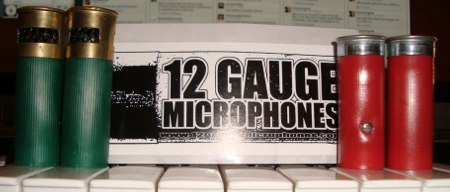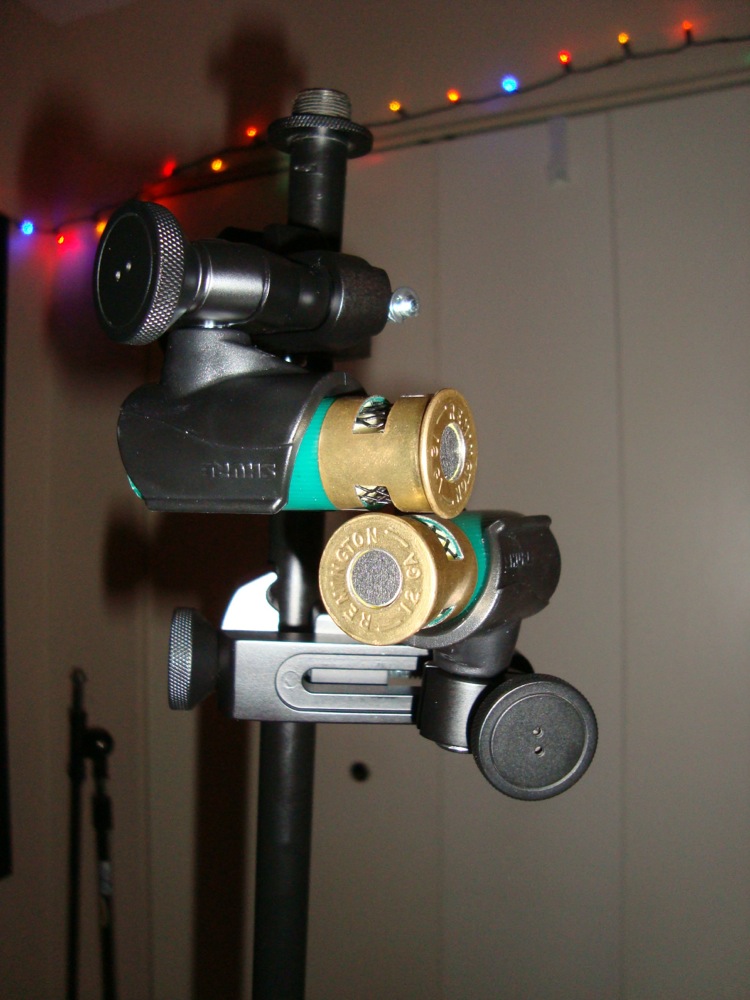Shotgun shell microphones, well that’s something different! A unique idea, a useful product and inexpensive. I don’t remember exactly how I came across 12 gauge microphones but I’m really glad I did. I sent an email to Brad Martin, the guy that builds these mics to request some samples to review. www.12gaugemicrophones.com

Brad makes two models, the Red12 omnidirectional condenser, and Green12 cardioid condenser. The mics don’t just look like shotgun shells, actual Winchester (red) and Remington (green) shells are used for the body, they’re the perfect size to house an XLR-M jack. Both mics use 10mm electret capsules and require 48V phantom power, though 9 or 12V would probably work also. To create the cardioid pattern, the Green12 has a 6mm cutout on each side below the capsule. The jack is glued in so unfortunately I couldn’t peek inside to see the other components.
Connecting these to a cable is a tight fit but easy enough. Finding a clip to attach them to a mic stand was a little more difficult. The mics don’t come with clips and these are super skinny with a diameter of just 19mm. I hate having to use duct tape but that was about all that worked when I first got these. Standard spring clips should also work if you’ve got some.

How do they sound?
These don’t sound like most small diaphragm condensers, they don’t have extended highs or super fast transient response. These have lots of mids, like comparing Genelecs to NS-10s. Maybe that’s what you need, maybe not. They have a fairly strong output level and moderate self-noise.
Here are some examples of the mics in a spaced overhead technique on acoustic guitar.
First up is the Green12 Cardioid condensers.
[audio:http://audiogeekzine.com/wp-content/uploads/12gauge/Guitar_green12.mp3|titles=Green12 stereo guitar overhead]
Now here is the Red12 Omnidirectional condensers.
[audio:http://audiogeekzine.com/wp-content/uploads/12gauge/Guitar_red12.mp3|titles=Red12 stereo guitar overhead]
I don’t have any great small diaphragm true condensers but I have two other electret mics, the Audio-Technica AT2021, and the Karma Audio K-Micro.
To compare these, I set up some test files to play out of a monitor with each mic 12 inches away, midway between the tweeter and woofer. The mics were at the same distance and were going through the same preamp with the same amount of gain.
Here is the test file.
[audio:http://audiogeekzine.com/wp-content/uploads/12gauge/test_clip.mp3|titles=Test file]
Here is the One of the Green12 cardioid mics pointed at a Yamaha HS50 monitor. Please note, the hum you hear is not the mics but my neighbour’s dishwasher that started up right when I started recording these examples. (yes I know this is a stupid excuse)
[audio:http://audiogeekzine.com/wp-content/uploads/12gauge/Green12.mp3|titles=12 Gauge Green12 Cardioid mono]
Here is the Red12 omni condenser
[audio:http://audiogeekzine.com/wp-content/uploads/12gauge/Red12.mp3|titles=12 Gauge Red12 Omni mono]
Up next is the Audio-Technica AT2021 cardioid condenser
[audio:http://audiogeekzine.com/wp-content/uploads/12gauge/AT2021.mp3|titles=Audio-Technica AT2021 Cardioid mono]
And lastly the Karma Audio K-Micro omni condenser
[audio:http://audiogeekzine.com/wp-content/uploads/12gauge/Kmicro.mp3|titles=Karma Audio K-Micro Omni mono]
Each of these mics sound very different. The K-Micro had the most output level, about 2.5 dB hotter than the Red12 and pretty close to the Green12, but almost 10dB hotter than the AT2021.
The differences in level between each model in the 12 gauge stereo pairs was about 1/10th of a decibel, although there was a slightly brighter mic in each pair.
Tonally, the Red12 sound the best to me, the others seem to have a shrill high frequency ringing, each at different frequencies. The Green12 has a more pronounced mid frequency and low frequency rolloff.
Obviously if you don’t like DIY gear, you’re not going to like the look of these. All the people I’ve shown these to thought they were really cool. They make a good useful gift for musicians and engineers.
For $35 each the Red12 work pretty nicely on acoustic guitar, and would probably be great for dirty room mics. The Green12 for $50 has a more contoured frequency response that I didn’t prefer for acoustic guitars, especially one that already has a lot of midrange. I could see it working well under a snare, or as an extra mic on electric guitar to get an aggressive tone.
Are these my favorite mics in the world? Definitely not. Would I recommend them? Yes. They work well, they’re hand built and met my expectations for the price point.
Buy 12 gauge microphones at www.12gaugemicrophones.com

Wow, what a cool idea! And they’re quite inexpensive too! Did they seem built in a sturdy way? Also, how well did they fit into the 57 mic clips?
The build is sturdy, they are lightweight, the jacks are glued and screwed in so they should last a long time.
They’re too skinny for standard mic clips, could be inconvenient. They are 19mm in diameter. The clips I’m using now Shure A75M cost double what the mics do.
Thanks! Much appreciated 🙂
Definetly, AT sounds MUCH BETTER, more definition, more clean, much noiseless and much more usable sound than thos shotgun bullets…
btw they have a quite good price if you just want to start in the world of recording.
I completely disagree. The AT2021 mics are FASTER being a FET design, but require 10dB more gain (more preamp noise) and overall sound thin to me. The 2021s are good as an extra mic for capturing some articulation but I’ve never been happy with them alone, I’ve owned a pair for about 6 years now.
That said, I tend to prefer large diaphragm condensers in almost any application.